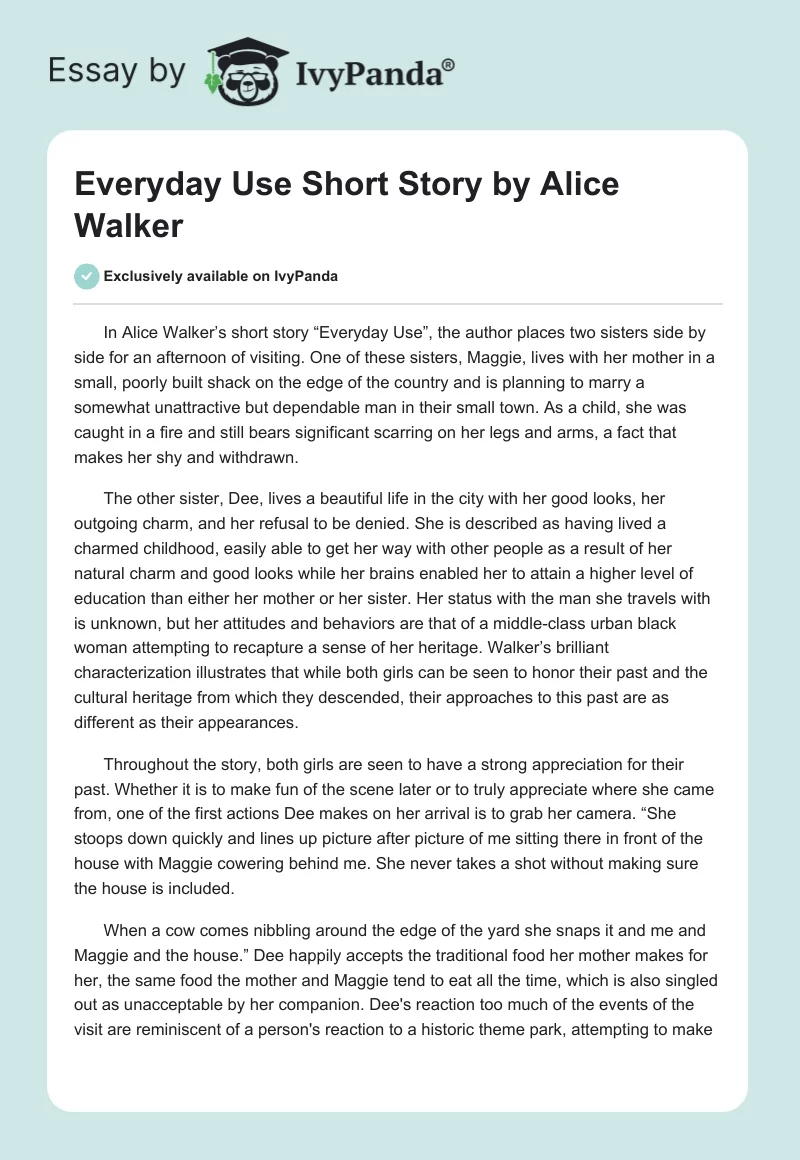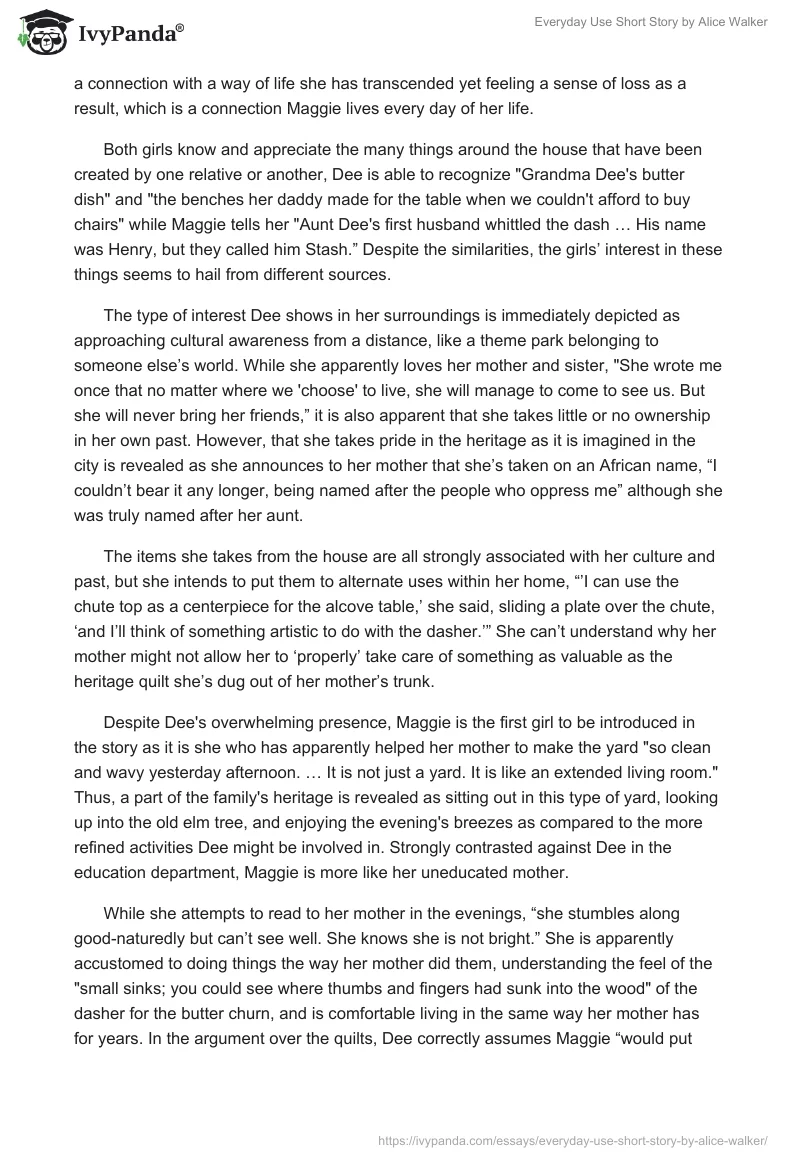In Alice Walker’s short story “Everyday Use”, the author places two sisters side by side for an afternoon of visiting. One of these sisters, Maggie, lives with her mother in a small, poorly built shack on the edge of the country and is planning to marry a somewhat unattractive but dependable man in their small town. As a child, she was caught in a fire and still bears significant scarring on her legs and arms, a fact that makes her shy and withdrawn.
The other sister, Dee, lives a beautiful life in the city with her good looks, her outgoing charm, and her refusal to be denied. She is described as having lived a charmed childhood, easily able to get her way with other people as a result of her natural charm and good looks while her brains enabled her to attain a higher level of education than either her mother or her sister. Her status with the man she travels with is unknown, but her attitudes and behaviors are that of a middle-class urban black woman attempting to recapture a sense of her heritage. Walker’s brilliant characterization illustrates that while both girls can be seen to honor their past and the cultural heritage from which they descended, their approaches to this past are as different as their appearances.
Throughout the story, both girls are seen to have a strong appreciation for their past. Whether it is to make fun of the scene later or to truly appreciate where she came from, one of the first actions Dee makes on her arrival is to grab her camera. “She stoops down quickly and lines up picture after picture of me sitting there in front of the house with Maggie cowering behind me. She never takes a shot without making sure the house is included.
When a cow comes nibbling around the edge of the yard she snaps it and me and Maggie and the house.” Dee happily accepts the traditional food her mother makes for her, the same food the mother and Maggie tend to eat all the time, which is also singled out as unacceptable by her companion. Dee’s reaction too much of the events of the visit are reminiscent of a person’s reaction to a historic theme park, attempting to make a connection with a way of life she has transcended yet feeling a sense of loss as a result, which is a connection Maggie lives every day of her life.
Both girls know and appreciate the many things around the house that have been created by one relative or another, Dee is able to recognize “Grandma Dee’s butter dish” and “the benches her daddy made for the table when we couldn’t afford to buy chairs” while Maggie tells her “Aunt Dee’s first husband whittled the dash … His name was Henry, but they called him Stash.” Despite the similarities, the girls’ interest in these things seems to hail from different sources.
The type of interest Dee shows in her surroundings is immediately depicted as approaching cultural awareness from a distance, like a theme park belonging to someone else’s world. While she apparently loves her mother and sister, “She wrote me once that no matter where we ‘choose’ to live, she will manage to come to see us. But she will never bring her friends,” it is also apparent that she takes little or no ownership in her own past. However, that she takes pride in the heritage as it is imagined in the city is revealed as she announces to her mother that she’s taken on an African name, “I couldn’t bear it any longer, being named after the people who oppress me” although she was truly named after her aunt.
The items she takes from the house are all strongly associated with her culture and past, but she intends to put them to alternate uses within her home, “’I can use the chute top as a centerpiece for the alcove table,’ she said, sliding a plate over the chute, ‘and I’ll think of something artistic to do with the dasher.’” She can’t understand why her mother might not allow her to ‘properly’ take care of something as valuable as the heritage quilt she’s dug out of her mother’s trunk.
Despite Dee’s overwhelming presence, Maggie is the first girl to be introduced in the story as it is she who has apparently helped her mother to make the yard “so clean and wavy yesterday afternoon. … It is not just a yard. It is like an extended living room.” Thus, a part of the family’s heritage is revealed as sitting out in this type of yard, looking up into the old elm tree, and enjoying the evening’s breezes as compared to the more refined activities Dee might be involved in. Strongly contrasted against Dee in the education department, Maggie is more like her uneducated mother.
While she attempts to read to her mother in the evenings, “she stumbles along good-naturedly but can’t see well. She knows she is not bright.” She is apparently accustomed to doing things the way her mother did them, understanding the feel of the “small sinks; you could see where thumbs and fingers had sunk into the wood” of the dasher for the butter churn, and is comfortable living in the same way her mother has for years. In the argument over the quilts, Dee correctly assumes Maggie “would put them on the bed and in five years they’d be in rags.” Maggie is thus seen as a quiet girl, unassuming and meek, who nevertheless has practical ideas and plans of her own.
Through characterization, Walker is able to depict two very different sisters not just in the way they are described physically, but also through their different approaches to life. While Dee is active, constantly in motion, and constantly adapting the world to her own uses, Maggie is quiet, often in the background, and ready to employ the tools of the world to practical uses. Dee wants the top to the butter churn because of its cultural significance, its obvious age, and its personal family history.
While Maggie appreciates all of these qualities as well, she values the churn top because without it, the rest of the churn is useless and she can no longer make butter. In the same way, Dee appreciates the hand-pieced quilts because of all the work and care that went into them as well as the historical significance of the fabrics used while Maggie appreciates them for all this history as well as the possibility of them keeping her warm in the winter nights and making her beds beautiful in the daytime.
Works Cited
Walker, Alice. “Everyday Use.” 2008. Web.


